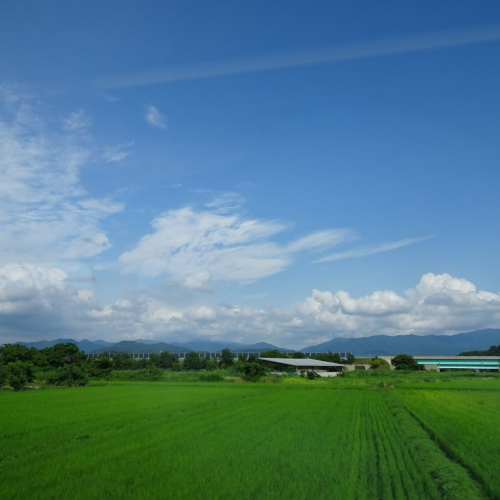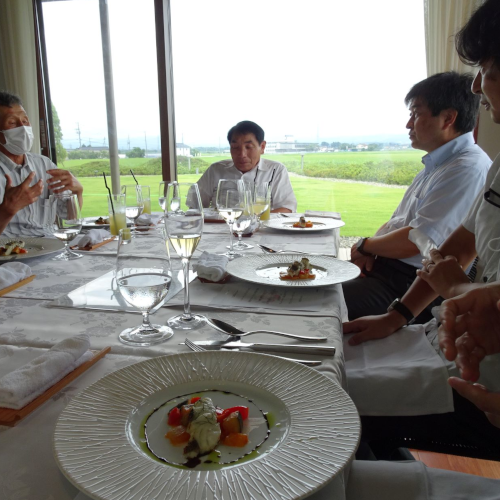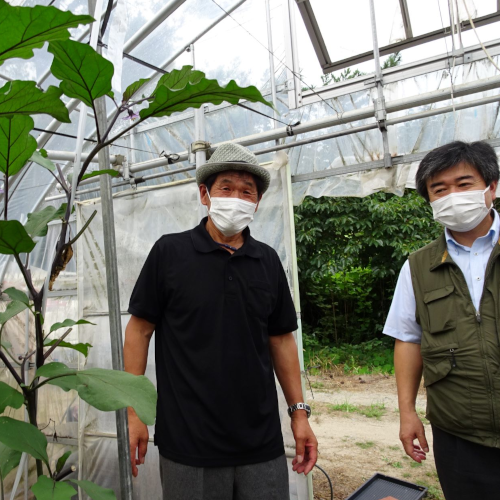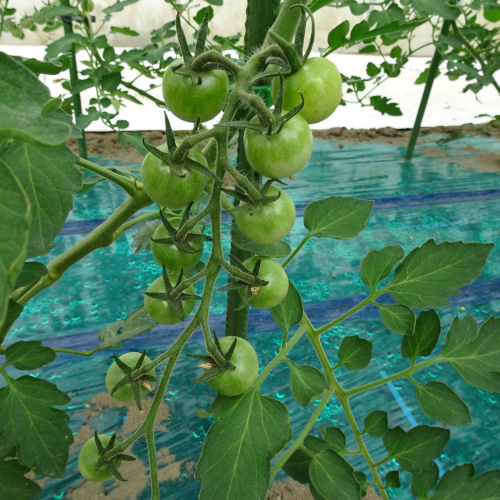山形県酒田市・庄内地方の植酸会を訪ねて
山形県の北西部に位置する庄内地方は、山々と日本海に囲まれ抱かれた、歴史ある文化的な地である。訪れたのは、8月半ば。青空と山の稜線の境目がくっきりとして、眩しい。そして、その中でひときわ目立つのが緑をたっぷりと含んだ平野部だ。空高く舞うツバメやとんぼたち。揺れる稲たち、青々と育つ野菜たち。その景色は、まさに日本の原風景と言いきれるような美しさに満ちている。
この風景の重要な構成員である稲や野菜たちは、いうまでもなくわたしたちの食卓にのぼり口に運ばれるのだが、その美味しさや安全性を長年追求してきた人々がいる。「庄内植酸会」の皆さんだ。
「植酸農法と出会ってから、もう30年以上になりますかね」。酒田市の肥料商「(有)佐藤長蔵商店」の代表取締役を務める坪池兵一さんは語る。「各種野菜や米、果物、園芸などでも研究を重ねてきましたが、野菜はやはり肥料や土壌改良剤の効果・成果が見えるのが早い気がします」。(有)佐藤長蔵商店は、地域に根差した老舗の肥料商で、自然環境と農作物双方の健康に着目してきた。
先代の代表・佐藤慶治郎氏が、弊社の創業者である増田俊雄と出会い、植酸に関する理念に魅せられ意気投合、植酸肥料の普及に尽力するようになって40年を超える。
そして「庄内植酸会」は、兵一さんをはじめとする有志で立ち上げられ、今に至る。野菜農家さんが多いのが特徴だ。庄内地方は、日本有数の穀倉地帯として知られるが、様々な種類の野菜も全国に出荷されている。そして、庄内植酸会の野菜の美味しさ・安全性は、地産地消のイタリアンで知られる「アルケッチァーノ」にも認められ、もう20年のお付き合いになるという。
今回、その「アルケッチァーノ」本店において、庄内植酸会の皆さんと会食をしながら、肥料の使い方と農業について意見交換する機会があった。
「コーゲンGは育苗のときには250倍までOKだというけれど、葉物では
何倍ぐらいが良いんだろう?」「葉物は500倍までが限度かなあ。300倍では濃いよね。」「葉面散布は夕方にするのがいいというのは理由があって、光合成との関係があるから。」「植物が生きている証拠だねー。」
「ゼリータイドの葉面散布は勧めていないんだ。葉っぱに白く残ってしまう場合があるから。」「そういえば、地元では育苗箱が誰のものか分からなくなってしまうことがあるんだけど、コーゲンGはカビが生えるのを防ぐ効果があるような気がする。」「ケイ酸は高温障害に効くというデータが出てきてるね。」「高温障害についても、野菜自身が健康だとダメージを受けにくい。」等々、話は尽きず、しかしナイフとフォークも止まることがない。地元食材をふんだんに使った美味しいお料理に舌鼓を打ちながら、各人の声帯も同時に活躍するというなんとも賑やかで実りある会食となった。
会議場は、レストランから、皆さんのfieldである「農園」へと移行する。
佐藤静雄さんのナス栽培のビニールハウス。その日の分の収穫が終わった後だったが、残っているナスを生のまま試食させていただく。みずみずしくて、そしてえぐみが殆どなく、さらに甘いのだ。Lサイズの大きなナスである。デパートなどにも依頼されて卸している、立派な風貌と味だ。「シュウ酸が多いとアクのもとになるんだよね。それは土壌の環境による。土が如何に大事かということ、ここでもわかりますよね。」静雄さんがナスを育てるのに使っているのは、植酸資材全般。特に今は欠かせないのは植酸PKマグと植酸ゼリータイド。「俺の所、砂丘地で肥料が下に流れ出てもったいないけれど、液肥を施用して先に根から養分吸われて、後から玉肥やってゆっくり吸わせるようにしている。」植酸資材はナス育成の相棒である。ユーモラスで親しみやすい静雄さんだが、毎日の収穫時は一仕事である。奥様の袋詰めの速さと的確さはまさにプロ、とみんなが口をそろえる。様々な作業を経て、このナスたちは旅立っていく。
坪池豊さんのミニトマトのハウスは、色とりどりの小さな楽園のようなのだった。「どんどん採って食べてくださいね」と優しい笑顔の豊さん。ミニトマトにも様々な種類がある。小ぶりで締まったもの、長細いもの、黄色いもの等々。遠慮なく味比べをさせて頂くと、その味の違いにあらためて気付く。「黄色いのはあまり人気がないんだよね」と豊さんはおっしゃるが、食べると驚くほど甘く癖がない。ここでは植酸コーゲンGを始めとして植酸資材が、ひそかに活躍している。根を守ってくれる資材だから、ミニトマトが肥料養分を素直に吸収してくれて、甘みが強くなる等の効果がみられるという。豊さんには、袋いっぱいにミニトマトをいただいた。袋を開けると、宝石のようにトマトたちが輝いていた。
比較的年齢層の高めな庄内植酸会であるが、ここで平均年齢をぐっと下げる農家さん登場。川村拓真さん、20代の専業農家である。地元の農業高校・農業大学校、1年間のオランダ研修を経て、就農6年目という拓真さんは、ミニトマトをはじめ野菜の栽培に取り組んでいる。「オランダの研修先は、高さが5~7m程あるガラスハウスで、中玉トマトを8ha栽培しているという会社でした。生育環境の調整や栽培技術、仕事への向き合い方など、現地の人たちと暮らす中で学び、活かせるところは工夫して実践しているところです。」最初の1年目は農協を介しての出荷だったが、そこから庄内植酸会と出逢い、独自のスタイルを追求している期待の若手である。
「土壌改良でブロートFを散布し、ゼリータイドとPKマグで生育を促しつつ、コーゲンGやイオンカルシウムで作物の生理循環を整え、液体けい酸加里で根を強化しているというイメージです」と、拓真さん。「美味しい野菜を追求していく中で品種の選定も重要だと思うのですが、以前はうまく栽培できなかった品種も、肥料を工夫するようになってから生育が上手く進むようになり、栽培できる野菜の幅が広がったという実感があります。」
日本のこれからの農業について、どのような展望を持っているのか、ということについても若い拓真さんに伺ってみた。今、日本は第一次産業の在り方が問われている重要なターニングポイントにあると感じているので。
「地域で助け合いながら、技術の継承があったり、土地の特性や疑問点などを聞ける機会がある。効率化や集約化が進むなかでも、強引には解決できない課題が出てくるとき、お互いの関係性を築いておくことは重要だと感じています。」「日本の農業は、かなりの部分で『自然と共に』作物をつくることが多いと思うんです。地域を活かしながら、それぞれに合った作物を、技術を模索しながら栽培していく、それが日本の農業の発展につながっていくのではないかと思います」。
庄内植酸会の先輩たちのアドバイス等も受けながら、日々トライをし続ける拓真さんの姿は、これからの農を担っていく頼もしさのようなものを感じた。
世代を越えて、美味しさや安全性、さらには地球環境という大きな課題もプラスされて、庄内での農業は受け継がれていく。
「赤潮は陸上の環境が大きな引き金となっている問題ですよね」と兵一さん。「生活・工業排水だけでなく、一部化学肥料の誤った形での大量投入なども原因となっている。自然の原理というものにもう一度人は目を向ける必要がありますよね」とも。
健康な土壌から健康な野菜や穀物が育つ。そしてそこでは多様なちいさな生物が豊かな世界を築いていく。日本の原風景は、郷愁を誘う過去の遺物ではなく、現在進行形、まさに生きているからこそ美しいのだろう。「里」における「農」という生業が、すこやかに継続されていくように、「里」を含めた豊かな生態系が、未来へバトンタッチされていくように。祈るような気持ちで現地を後にした。
お問い合わせは以下のメールアドレスまでお願いいたします。














